Highlighting Free-Recovery and Work-Generating Shape Memory Effects at 80r-PET Thermoformed Cups
Abstract
1. Introduction
- heating the end of a thermoplastic foil roll beyond its glass transition softening temperature;
- deforming it, inside a metallic die, to the final shape, by vacuum-forming, pressure-forming, or mechanical forming [8];
- rapidly cooling it, between 40 °C to 60 °C, to ensure the formation of a solid, glassy state;
- cutting the final shape of the cup by trimming;
- ejecting the final product out of the die [9].
- by radiation, on both sides of the polyethylene terephthalate (PET) film, during initial foil heating;
- by conduction and convection, during deep drawing, in two stages:
- conduction is caused by the foil contact firstly with the puncher and then with the die, which is internally water-cooled;
- convection, due to rapid foil cooling caused by high-pressure air blowing (about 8 bar), after the die closure [10].
- heating, when the foil is unwounded from the left side roll and passes between two heaters, being drawn by two lateral driving chains and reaches temperatures up to 120 °C in a matter of time up to 20 s;
- forming, during which the PET foil has a temporary stop, the die’s parts close and several punchers perform the air-assisted deep drawing process;
- cutting, while the foil is still stopped the die acts as a cutting station and the cups’ edges are trimmed and (iii) punching stations, respectively.
- air-ejection occurs after die opening, when high-pressure air is blown and the thermoformed cups are ejected into a stacker.
2. Materials and Methods
3. Results and Discussion
4. Summary and Conclusions
- the thermal analysis was performed by DSC and temperature scan-DMA. DSC thermograms revealed the presence of a glass transition, between 68 and 77 °C which can substantiate the occurrence of SME. DMA diagrams emphasized a marked storage modulus increase during the first heating cycle and a reversible decrease during heating and increase during cooling in the second cycle;
- the tensile failure tests displayed a marked necking illustrated by sharp stress decrease and an increasing tendency of ultimate tensile strain, from machine direction to transversal direction;
- the structural analysis was performed by SEM that illustrated the successive positions of specimen’s surface that gradually decreased the cross section surface during necking and an obvious increase in the number of consecutive failure layers, when passing from machine to transversal direction.
- the variation of FR-SME with temperature was determined under the form of Equation (3) which was verified at four different temperatures and gave errors below 5%, thus enabling a correct determination of any SME value obtained during heating between 70 and 120 °C;
- the variation of WG-SME with temperature experienced rates of shape recovery percentage with temperature that varied between 0.39625 and 0.70125%/°C during the heating from 65 to 97 °C of thermoformed cups filled water amounts between 140 and 220 mL;
- the variation of the WG-SME rate with temperature and load weight was approximated with a Boltzman function, with standard errors below 0.15%, and reached a maximum value of 0.7%/(°C);
- the thermoformed cups developed both FR-SME and WG-SME, reaching maximum values of 30% and 25%, respectively;
- the maximum specific work output developed by a thermoformed cup was 2.646 J/kg.
Author Contributions
Funding
Institutional Review Board Statement
Data Availability Statement
Acknowledgments
Conflicts of Interest
References
- Sun, L.; Huang, W.M.; Ding, Z.; Zhao, Y.; Wang, C.C.; Purnawali, H.; Tang, C. Stimulus-responsive shape memory materials: A review. Mater. Des. 2012, 33, 577–640. [Google Scholar] [CrossRef]
- Laso, M.; Cormenzana, J.L. Computational techniques for smart materials. In Encyclopedia of Smart Materials; Schwartz, M., Ed.; John Wiley & Sons: New York, NY, USA, 2022; Volume I and II, pp. 265–274. [Google Scholar]
- Irie, M. Shape memory polymers. In Shape Memory Materials; Otsuka, K., Wayman, C.M., Eds.; Cambridge University Press: Cambridge, UK, 1998; pp. 203–219. [Google Scholar]
- Huang, W.M.; Zhao, Y.; Wang, C.C.; Ding, Z.; Purnawali, H.; Tang, C.; Zhang, J.L. Thermo/chemo-responsive shape memory effect in polymers: A sketch of working mechanisms, fundamentals and optimization. J. Polym. Res. 2012, 19, 9952. [Google Scholar] [CrossRef]
- Liu, Y.; Wang, L.; Liu, Y.; Zhang, F.; Leng, J. Recent progress in shape memory polymer composites: Driving modes, forming technologies, and applications. Compos. Commun. 2024, 51, 102062. [Google Scholar] [CrossRef]
- Dong, W.; Zhao, J.; Li, C.; Guo, M.; Zhao, D.; Fan, Q. Study of the amorphous phase in semicrystalline poly(ethylene terephthalate) via dynamic mechanical thermal analysis. Polym. Bull. 2002, 49, 197–203. [Google Scholar] [CrossRef]
- Influence of the Cooling Rate on the Thermal Behavior of PET. Available online: https://analyzing-testing.netzsch.com/en/application-literature/influence-of-the-cooling-rate-on-the-thermal-behavior-of-pet#:~:text=glass%20transition%3A%20The%20higher%20the,crystallize%20during%20the%20fast%20cooling (accessed on 21 October 2024).
- Worgull, M. Thermoforming. In Hot Embossing, 2nd ed.; Worgull, M., Ed.; Elsevier: Amsterdam, The Netherlands, 2024; pp. 125–154. [Google Scholar]
- Athanasiou, K.A. Thermoforming Process Overview. In Fundamentals of Plastics Thermoforming; Klein, P.W., Ed.; Springer Nature: Berlin/Heidelberg, Germany, 2009; pp. 17–26. [Google Scholar]
- Throne, J.L. Understanding Thermoforming; Carl Hanser Verlag GmbH & Co. KG: Munich, Germany, 2008; pp. 9–25. [Google Scholar]
- Engelmann, S. Advanced Thermoforming: Methods, Machines and Materials, Applications and Automation; John Wiley & Sons: Hoboken, NJ, USA, 2012; pp. 76–83. [Google Scholar]
- Pricop, B.; Sava, S.D.; Lohan, N.-M.; Bujoreanu, L.-G. DMA Investigation of the Factors Influencing the Glass Transition in 3D Printed Specimens of Shape Memory Recycled PET. Polymers 2022, 14, 2248. [Google Scholar] [CrossRef] [PubMed]
- Sava, S.-D.; Lohan, N.-M.; Pricop, B.; Popa, M.; Cimpoeșu, N.; Comăneci, R.-I.; Bujoreanu, L.-G. On the Thermomechanical Behavior of 3D-Printed Specimens of Shape Memory R-PETG. Polymers 2023, 15, 2378. [Google Scholar] [CrossRef]
- Sava, S.-D.; Axinte, M.; Bădărău, G.; Bujoreanu, L.-G. Designing, manufacturing and testing of an experimental setup for the study of shape memory effect in R-PET thermoformed cups. Bull. Polyt. Inst. Iasi Sect. Mater. Sci. Eng. 2024, 70, 1–4, 87–97. Available online: https://sim.tuiasi.ro/wp-content/uploads/2024/12/Vol.-SIM-1-4-din-2024.pdf (accessed on 1 December 2024).
- Choi, S.; Jang, S.; Yoo, S.H.; Lee, G.W.; Choi, D. Evaluation of Shape Recovery Performance of Shape Memory Polymers with Carbon-Based Fillers. Polymers 2024, 16, 2425. [Google Scholar] [CrossRef]
- Shieh, Y.-T.; Lin, Y.-S.; Twu, Y.-K.; Tsai, H.-B.; Lin, R.-H. Effect of crystallinity on enthalpy recovery peaks and cold-crystallization peaks in PET via TMDSC and DMA studies. J. Appl. Polym. Sci. 2010, 116, 1334–1341. [Google Scholar] [CrossRef]
- Poluektov, M.; van Dommelen, J.A.W.; Govaert, L.E.; Geers, M.G.D. Characterisation and modelling of anisotropic thermo-mechanical behaviour of oriented polyethylene terephthalate. Model. Simul. Mater. Sci. Eng. 2014, 22, 055024. [Google Scholar] [CrossRef]
- Poluektov, M.; van Dommelen, J.A.W.; Govaert, L.E.; Geers, M.G.D. Micromechanical modelling of reversible and irreversible thermo-mechanical deformation of oriented polyethylene terephthalate. Comput. Mater. Sci. 2015, 98, 189–200. [Google Scholar] [CrossRef][Green Version]
- Yamanaka, Y.; Kitagawa, J.; Kojima, K.; Nakano, H. Effect of Crystal Structural Changes of PET in Can-making Process on Properties of Film Laminated Steel for Containers. ISIJ Int. 2018, 58, 2330–2337. [Google Scholar] [CrossRef]
- Lechat, C.; Bunsell, A.R.; Davies, P. Tensile and creep behaviour of polyethylene terephthalate and polyethylene naphthalate fibres. J. Mater. Sci. 2011, 46, 528–533. [Google Scholar] [CrossRef]
- Li, Z.; Yang, W.; Xie, B.; Huang, R.; Yang, M.; Feng, J. Influences of Tensile Deformation Rate on Deformation and Morphology of Injection Molded 15/85 (by Weight) PC/PE and PET/PE Blends with High Interfacial Contact. J. Macromol Sci. B 2004, 43, 519–542. [Google Scholar] [CrossRef]
- O’Driscoll, C.; Owodunni, O.; Asghar, U. Optimization of 3D printer settings for recycled PET filament using analysis of variance (ANOVA). Heliyon 2024, 10, e26777. [Google Scholar] [CrossRef] [PubMed]
- Zisopol, D.G.; Minescu, M.; Iacob, D.V. A Study on the Influence of FDM Parameters on the Tensile Behavior of Samples made of PET-G. Eng. Technol. Appl. Sci. Res. 2024, 14, 13487–13492. [Google Scholar] [CrossRef]
- DIN EN ISO 527-2:2012; Plastics—Determination of Tensile Properties—Part 2: Test Conditions for Moulding and Extrusion Plastics. International Organization for Standardization: Geneva, Switzerland, 1993.
- Meza de Luna, A.; Shaikh, F.U.A. Anisotropy and bond behaviour of recycled Polyethylene terephthalate (PET) fibre as concrete reinforcement. Constr. Build. Mater. 2020, 265, 120331. [Google Scholar] [CrossRef]
- Mazidi, M.M.; Aghjeh, M.K.R.; Pegoretti, A. Toughened ternary and quaternary polymer alloys of core-shell morphology; correlations among processing, microstructure, micromechanics, and macroscopic mechanical performance in reactive systems. Polymer 2023, 282, 126186. [Google Scholar] [CrossRef]
- Hayes, M.D.; Edwards, D.B.; Shah, A.R. Fractography in Failure Analysis of Polymers; Elsevier: Amsterdam, The Netherlands, 2015; pp. 48–92. [Google Scholar]
- Alarifi, I.A. PETG/carbon fiber composites with different structures produced by 3D printing. Polym. Test 2023, 120, 107949. [Google Scholar] [CrossRef]
- Safaei, S.; Ayatollahi, M.R.; Saboori, B. Fracture behavior of GPPS brittle polymer under mixed mode I/III loading. Theor. Appl. Fract. Mech. 2017, 91, 103–115. [Google Scholar] [CrossRef]
- Wu, X.; Tiwari, V.M.; Suryarao, K.P.; Tan, R.; Xiao, R.; Lv, H.; Zhang, Y.; Wang, Z.; Huang, W.M. Patterned Colouring via Variable-Speed Single Stretching. Inventions 2022, 7, 93. [Google Scholar] [CrossRef]
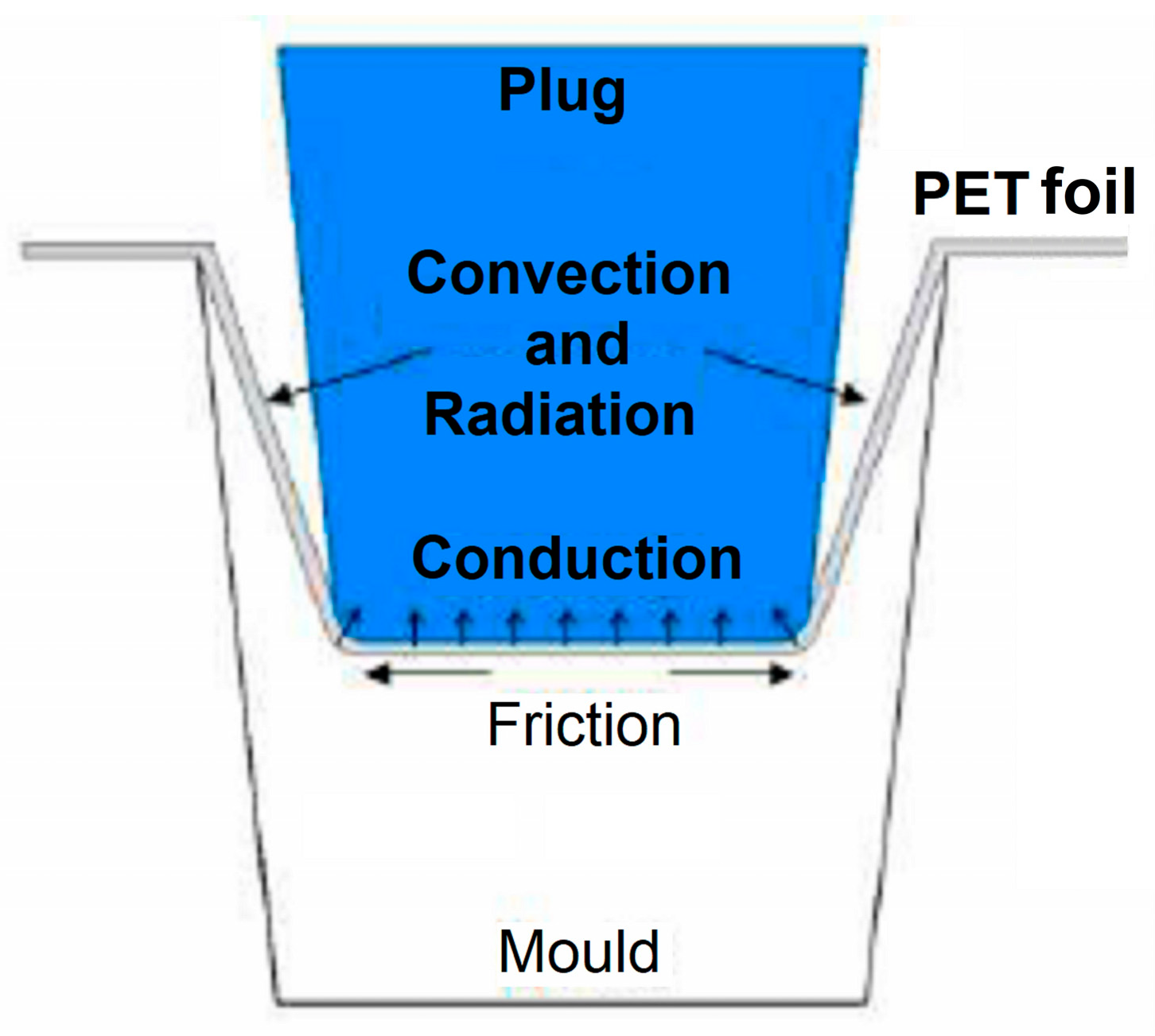
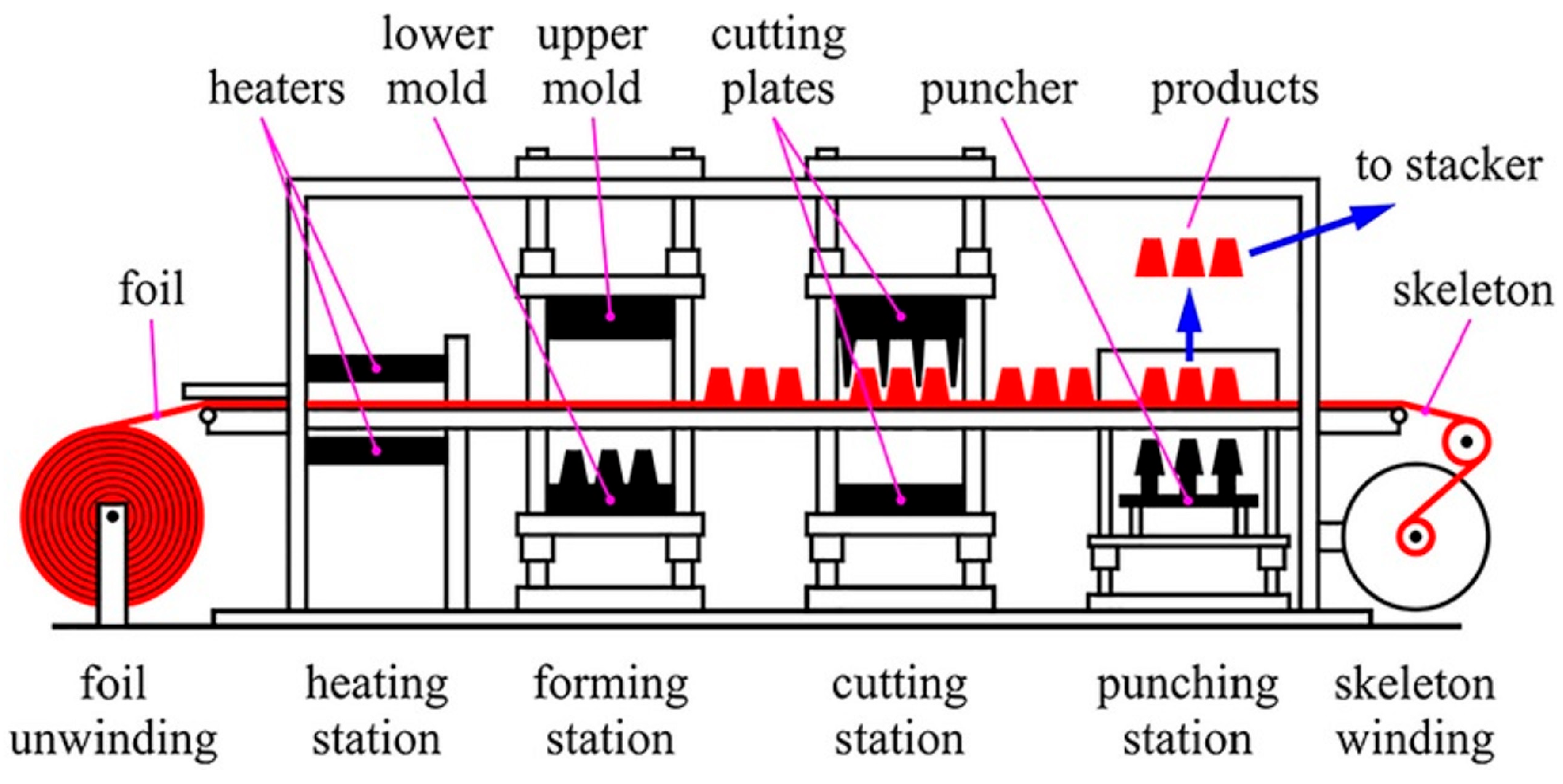


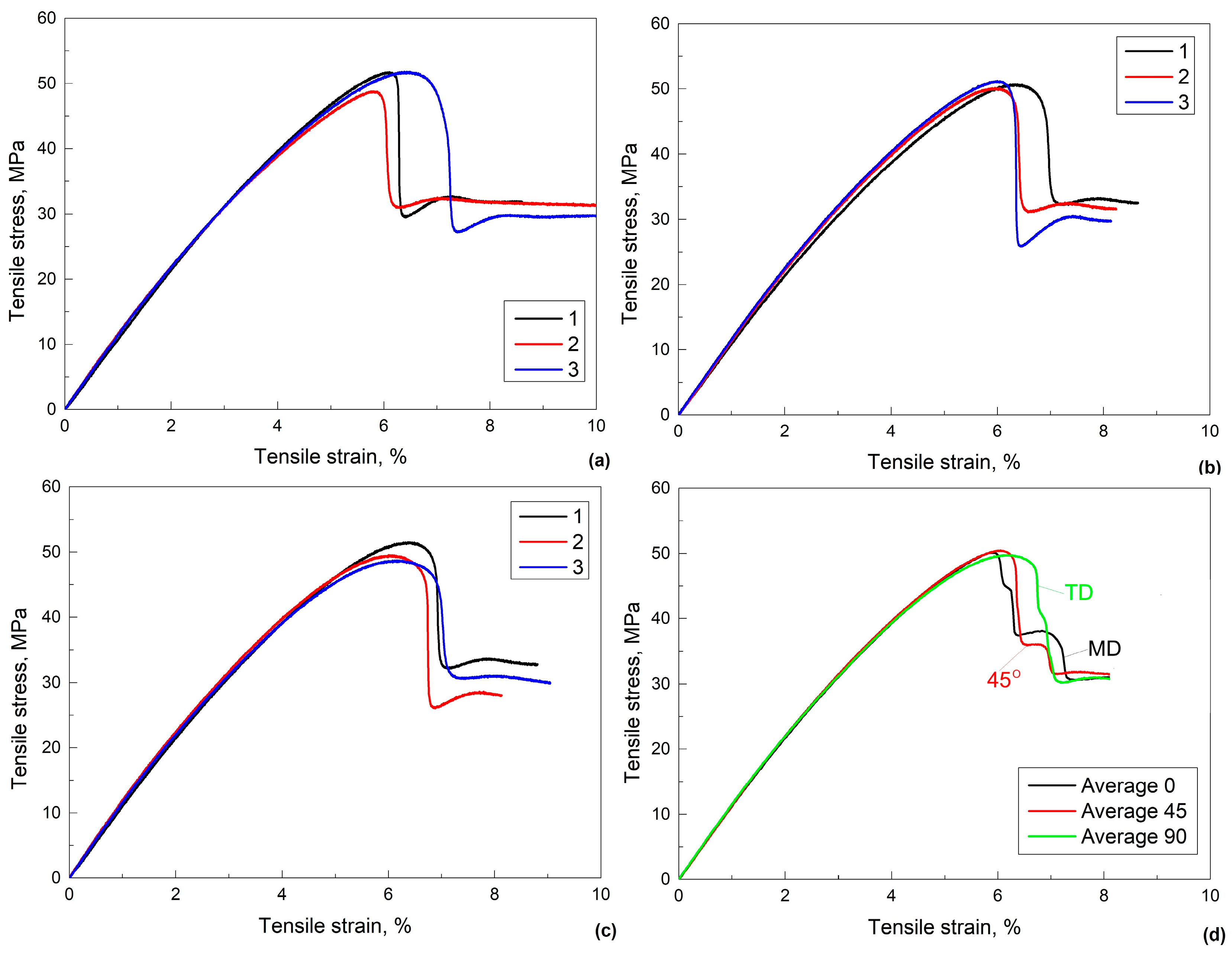
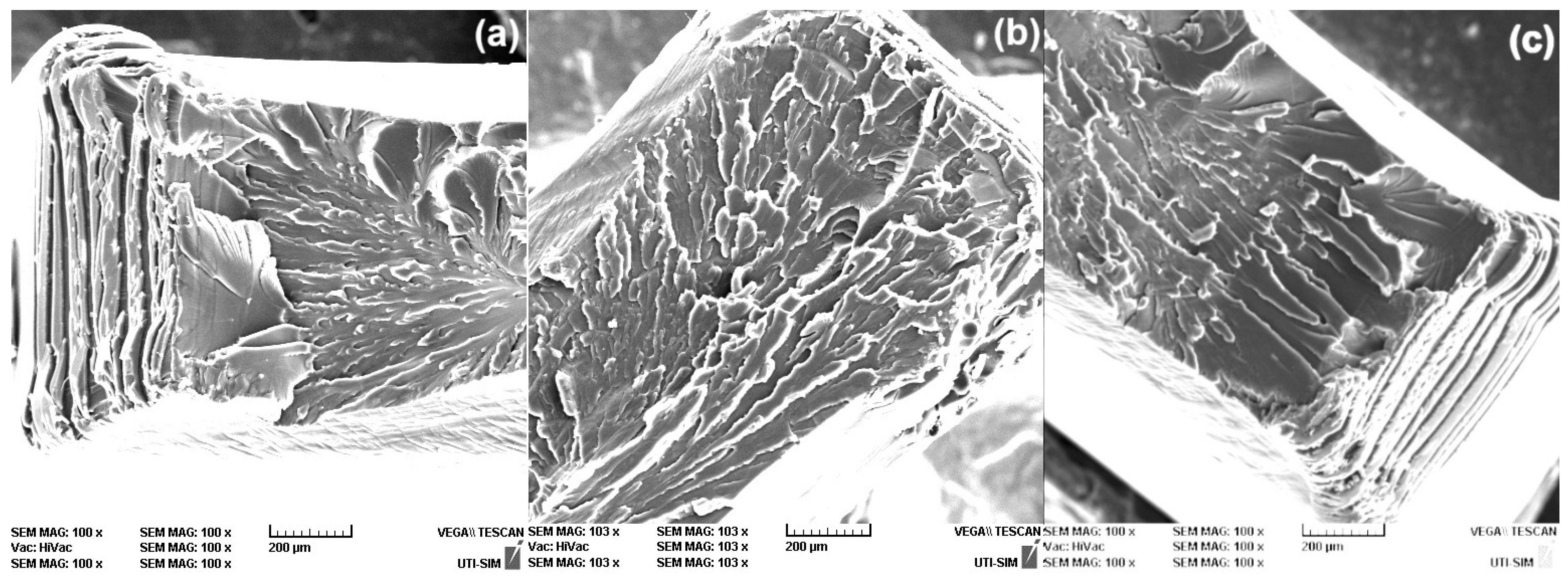
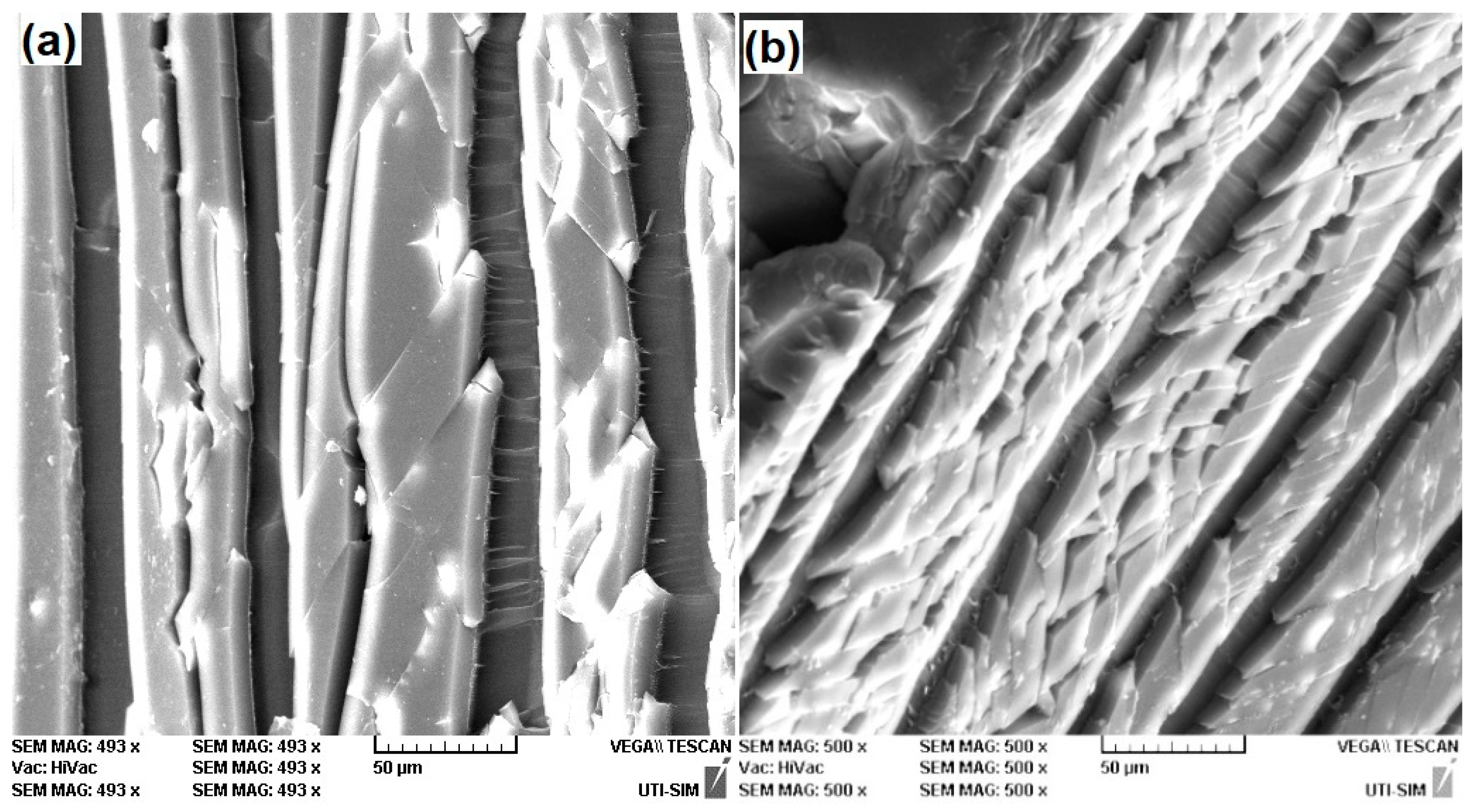



| Specimen | Maximum Load | Young Modulus | Yield Stress | Yield Strain | Tensile Stress | Tensile Strain | |
|---|---|---|---|---|---|---|---|
| Orientation | No | N | MPa | MPa | mm/mm | MPa | % |
| 0° | 1 | 285.6 | 1065.01 | 44.88 | 0.05 | 51.74 | 6.1 |
| 2 | 269.26 | 1211.59 | 32.72 | 0.03 | 46.75 | 5.26 | |
| 3 | 285.98 | 1159.71 | 35.98 | 0.04 | 49.8 | 5.69 | |
| 45° | 1 | 279.82 | 1062.59 | 41.48 | 0.04 | 50.69 | 6.37 |
| 2 | 276.78 | 1095.84 | 42.88 | 0.04 | 50.14 | 5.96 | |
| 3 | 282.68 | 1175.99 | 38.6 | 0.04 | 51.21 | 6 | |
| 90° | 1 | 284.36 | 1058.19 | 43.45 | 0.05 | 51.51 | 6.36 |
| 2 | 273.57 | 1212.8 | 34.54 | 0.03 | 49.56 | 6 | |
| 3 | 269.04 | 1185.38 | 34.53 | 0.03 | 48.74 | 6.16 | |
| Temperature | SMEex | SMEth | Error |
|---|---|---|---|
| °C | % | % | % |
| 81 | 10 | 9.48293 | 1.57 |
| 87 | 13.75 | 13.5094 | 1.75 |
| 96 | 20 | 19.009 | 4.96 |
| 112 | 30 | 28.7861 | 4.05 |
Disclaimer/Publisher’s Note: The statements, opinions and data contained in all publications are solely those of the individual author(s) and contributor(s) and not of MDPI and/or the editor(s). MDPI and/or the editor(s) disclaim responsibility for any injury to people or property resulting from any ideas, methods, instructions or products referred to in the content. |
© 2024 by the authors. Licensee MDPI, Basel, Switzerland. This article is an open access article distributed under the terms and conditions of the Creative Commons Attribution (CC BY) license (https://creativecommons.org/licenses/by/4.0/).
Share and Cite
Sava, Ș.-D.; Pricop, B.; Popa, M.; Lohan, N.-M.; Matcovschi, E.; Cimpoeșu, N.; Comăneci, R.-I.; Bujoreanu, L.-G. Highlighting Free-Recovery and Work-Generating Shape Memory Effects at 80r-PET Thermoformed Cups. Polymers 2024, 16, 3598. https://doi.org/10.3390/polym16243598
Sava Ș-D, Pricop B, Popa M, Lohan N-M, Matcovschi E, Cimpoeșu N, Comăneci R-I, Bujoreanu L-G. Highlighting Free-Recovery and Work-Generating Shape Memory Effects at 80r-PET Thermoformed Cups. Polymers. 2024; 16(24):3598. https://doi.org/10.3390/polym16243598
Chicago/Turabian StyleSava, Ștefan-Dumitru, Bogdan Pricop, Mihai Popa, Nicoleta-Monica Lohan, Elena Matcovschi, Nicanor Cimpoeșu, Radu-Ioachim Comăneci, and Leandru-Gheorghe Bujoreanu. 2024. "Highlighting Free-Recovery and Work-Generating Shape Memory Effects at 80r-PET Thermoformed Cups" Polymers 16, no. 24: 3598. https://doi.org/10.3390/polym16243598
APA StyleSava, Ș.-D., Pricop, B., Popa, M., Lohan, N.-M., Matcovschi, E., Cimpoeșu, N., Comăneci, R.-I., & Bujoreanu, L.-G. (2024). Highlighting Free-Recovery and Work-Generating Shape Memory Effects at 80r-PET Thermoformed Cups. Polymers, 16(24), 3598. https://doi.org/10.3390/polym16243598










